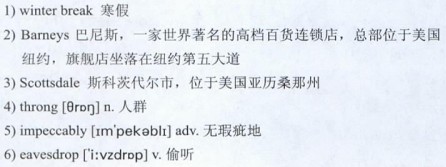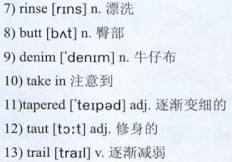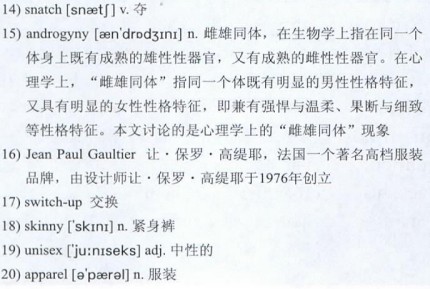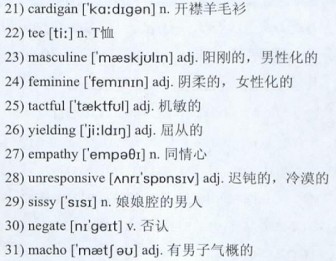文字难度:★★★
Over 1)winter break, I had the opportunity to visit the newly opened 2)Barneys in my hometown,3)Scottsdale. Among the 4)throngs of 5)impeccably dressed shoppers, I couldn’t help but 6)eavesdrop on a particularly chic couple hovering near the dressing rooms, modeling potential purchases for one another. The Girlfriend stood in the open doorway, posing in a pair of tight dark-7)rinse jeans. Wrinkling her nose as she checked out her 8)butt in the mirror, she asked The Boyfriend, “So what about these?”
The Boyfriend shrugged, holding out a pair of slim black 9)denim pants towards The Girlfriend. “I actually really like these. What do you think?”
The Girlfriend turned the jeans over in her hands, 10)taking in their 11)tapered legs and 12)taut cut through the thigh. Her eyes widened as she exclaimed, “These are perfect! I could wear them with my black boots.” Her voice 13)trailed once she saw the look of confusion and embarrassment on The Boyfriend’s face.
“Actually,” he mumbled, 14)snatching the jeans back from her. “I meant I liked them for me.”
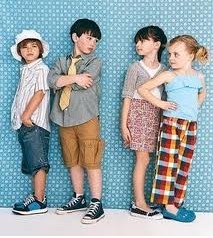 寒假期间,我有机会在我家乡斯科茨代尔市逛了逛新开张的巴尼斯百货连锁店。在衣着无可挑剔的顾客人流中,我不禁偷听到一对徘徊在试衣间附近、衣着尤其时尚的男女之间的对话,他们正在试穿其心仪的服装给对方看。那位女伴站在开阔的试衣间门口,穿着一条紧身的深色水洗牛仔裤在摆姿势。她一边看着镜子审视自己的臀部,一边皱起鼻子问她那位男伴,“这条裤子怎样?”
寒假期间,我有机会在我家乡斯科茨代尔市逛了逛新开张的巴尼斯百货连锁店。在衣着无可挑剔的顾客人流中,我不禁偷听到一对徘徊在试衣间附近、衣着尤其时尚的男女之间的对话,他们正在试穿其心仪的服装给对方看。那位女伴站在开阔的试衣间门口,穿着一条紧身的深色水洗牛仔裤在摆姿势。她一边看着镜子审视自己的臀部,一边皱起鼻子问她那位男伴,“这条裤子怎样?”
男伴耸耸肩,给那位女伴递上一条修身的黑色牛仔裤,“我其实真喜欢这条裤子,你觉得如何?”
女伴拿过那条裤子翻到另一面看,她注意到那条裤子的窄脚设计,大腿处的剪裁也很修身。她睁大眼睛喊道,“这条裤子很好看!我可以用它搭配我那双黑色长靴穿。”她一看见男伴一脸的迷茫和尴尬,那话音就变弱了。
“事实上,”他从她手中夺回那条牛仔裤,咕哝道,“我是说这很合我意。”
Weirdly, the scene I saw at Barneys shouldn’t have been as awkward for The Boyfriend as you’d think. 15)Androgyny is quite common in the fashion industry. Several new ads from 16)Jean Paul Gaultier feature models in role 17)switch-ups, with guys in slim 18)skinnies and women in baggy “boyfriend” style jeans. And it’s not just high fashion companies that are selling androgynous clothing. 19)Unisex lines at American 20)Apparel and Urban Outfitters, offering 21)cardigans and 22)tees in dozens of colors, make the gender-ambiguous apparel trend even more accessible to the public.
When it comes to our life, is androgyny everywhere? Our gender roles affect almost every aspect of our lives, but few of us spend much time thinking about them. If a man cries at times, is he less 23)masculine? If a woman tries to assert herself, is she less 24)feminine? In most cultures, there are distinct roles for men and women. Men are seen as having the competence traits, while women are seen as more expressive. Men are seen as aggressive and ambitious while women are 25)tactful and caring. But isn’t it narrow to equate masculinity with competency and femininity with expressiveness? In 1974, a Stanford University psychologist, Sandra Bem, developed the concept of androgyny. “Andro-” means “man,” and “gyn-” refers to “woman.” The androgynous person is high in both masculine and feminine traits. Androgynous people can be aggressive or 26)yielding, forceful or gentle, sensitive or assertive—as the particular situation requires.
Usually, bright or creative people tend to be androgynous. Androgynous people are more adaptable. They behave in ways appropriate to the given situation—regardless of whether the behavior is masculine or feminine. For example, when subjected to group pressures, androgynous women are more assertive and independent than feminine women.
奇怪的是,我在巴尼斯百货连锁店看到的这番情景中那位男士并非你想象的那么奇怪。“雌雄同体”现象在时尚产业中颇为常见。让·保 罗·高缇耶品牌的几个新广告都以男女模特性别服饰大对调为主题——男的身穿紧身裤,女的则穿上宽松的“男性化”牛仔裤。而且还不止是高端时尚公司在销售“雌雄同体”服装。平价品牌“美国服饰”和“都市服饰”的中性服装系列也向大众提供了缤纷多彩的开襟羊毛衫和T恤,使得模糊性别的服饰潮流更加亲近大众。
当谈及我们的生活,“雌雄同体”现象是否无处不在?我们的性别角色几乎影响着我们生活的方方面面,但我们当中极少有人会花大量时间来思考这些性别角色。如果男人时不时哭泣,他是否少了些刚阳之气?如果女人试图坚持己见,她是否就少了些女人味?在大多数的文化中,男女角色分明。人们认为男性更有能力,女性则似乎更善于表达;男人更有闯劲,更有雄心,女性则更机敏,更有同情心。但问题是,如果认为能力强便是男性化,善于表达便是女性化,这种观点是否过于狭隘?1974年,斯坦福大学的一位心理学家桑德拉·本姆提出了“androgyny(雌雄同体)”这一概念。“Andro-”指“男性”,而“gyn-”指“女性”。“雌雄同体”的人同时明显具备男性和女性的许多特征。他们可以既有闯劲又顺从,既有力量又不失柔和,既敏感又决断——只要某个场合需要,他们能适时调整自己的表现。
通常,性格开朗或是具有创造力的人很可能是“雌雄同体”。“雌雄同体”的人更能适应环境。他们根据特定环境采取适当的行为方式——不论那种行为方式是否表现出男子气概抑或女性特质。例如,当遭受团队压力时,“雌雄同体”的女性相比一般女性更加自信满怀和独立自主。
Likewise, androgynous men are more nurturing than masculine men. Androgynous men feel more comfortable holding, touching and playing with babies: they are more able to show 27)empathy and offer support to others. However, stereotyped masculine men are typically 28)unresponsive in these situations. Rigid, stereotyped sex roles seriously restrict behavior. Masculine men have great difficulty in expressing warmth, playfulness and concern. They believe that expressing “feminine” traits will make them seem like “29)sissies” or 30)negate their “31)macho” image.
Similarly, feminine women have trouble being independent and assertive—even when independence and assertiveness are needed. In contrast, choosing from a wider range of behaviors, truly androgynous people are able to modify their responses—according to their needs and the needs of the situation. Bem believes that androgynous people are freer, more adaptable and more emotionally healthy than those who restrict their behavior to traditional sex roles.
Even so, men can be tender without losing their “macho.” Likewise, women can speak up for their rights without losing their femininity. Essentially, anyone’s behavior can be determined by their individual humanity or the demands of the situation—not merely by the restrictive roles of masculinity or femininity.
So when boy meets girl, it’s not just love, competition or fashion. It can also be androgyny.
同样地,“雌雄同体”的男性相比富有男子气概的男性更有爱心耐性。抱婴儿、抚摸婴儿,和小孩玩耍这些事,“雌雄同体”的男性做起来更得心应手。他们更能表现出同情心,向他人提供帮助。然而,男子气概凸显的传统男性在这些场合中则显得特别冷漠。呆板的传统性别角色严重局限了两性的行为模式。男子气概凸显的传统男性难于表达热情,不善嬉笑,关怀之心也难以表露。他们认为,表现出“女性”特征会使他们看上去“娘娘腔”,或是否定了他们的“男性”形象。
同样地,女性特质凸显的女性难于独立和信心满怀——即使当环境需要她们这样表现时。相反,真正的“雌雄同体”的人会根据自身以及环境的需求从范围更广的行为模式中,选择适当的方式来调整自己的行为,做出相应的反应。本姆相信,相比那些将自己的行为局限于传统性别角色的人来说,“雌雄同体”的人更自由,更能适应环境,其情绪处于更健康的状态。
尽管如此,男人可以在不丧失其“男子气概”的同时表现得更温柔一些。同样地,女人可以在不丧失其女人味的同时大声争取其权利。从本质上说,任何人的行为可以由其个体或处境的要求所决定——而不仅仅由严格意义上的性别角色所决定。
所以,当男孩遇上女孩,两人不仅会摩擦出爱的火花,会引发竞争或是时尚潮流,还可能是“雌雄同体”的这种境况。
